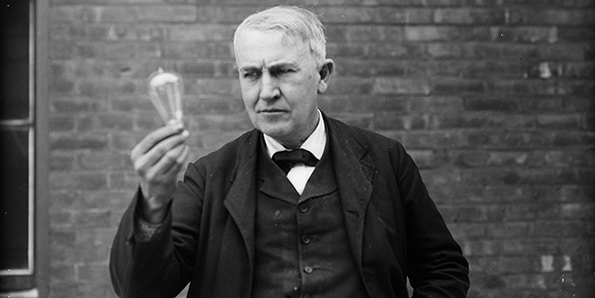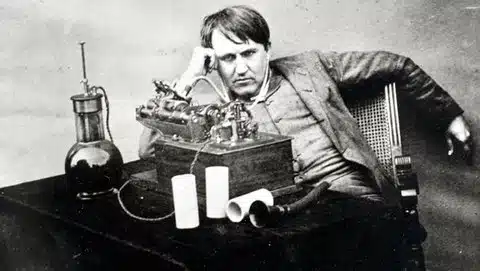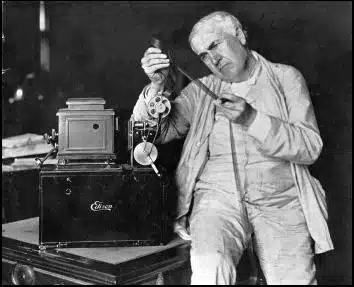Thomas Alva Edison was born on 11 February 1847 in Milan, Ohio USA, to a Canadian-born father of Dutch descent and a New York-born mother. He is credited with, and is probably best known for inventing the light bulb, phonograph and motion picture camera – all among the more than 1,000 patents eventually registered to him – plus founding the General Electric Company, Edison died on 18 October 1931, in West Orange, New Jersey USA.
So just how rich was Thomas Edison? Sources estimate that at the time of his death, Edison’s net worth was over $12 million, at today’s rate about $170 million. His wealth was accumulated over a period of more than 60 years, as a consequence of his inventions and business dealings.
Thomas Edison Net Worth $170 Million
Thomas was the youngest of seven children, and was largely home-schooled by his mother. His business mind and entrepreneurship was demonstrated early, as a young teen selling candy and newspapers on commuter trains around Detroit, until he secured exclusivity selling newspapers on the streets of nearby Port Huron, to where the family had moved when the rail-road by-passed Milan, and also selling his own self-produced newspaper – Grand Trunk Herald. His net worth was beginning to rise.
Edison became a telegraph operator, job training given to him by a grateful J. MacKenzie after Thomas saved his son from a rail accident. He subsequently moved to Louisville in Kentucky in 1866, to work for the Associated Press (AP) bureau of Western Union, but he was fired after an accident with battery acid caused damage to his boss’s desk. Regardless, Edison’s inventive mind saw him register his first patents in 1869, an electric vote recorder and a stock ticker, adding eventually to his net worth.
Thomas built a complex at Menlo Park specifically to invent and improve mostly electrical products, to improve knowledge, and soon followed with registering various improvements to telegraphic equipments, but the first of Edison’s major inventions and patents was the phonograph in 1877, a totally new and unforeseen product, which earned him the nickname of The Wizard of Menlo Park. The quadruplex telegraph followed, bought by Western Union for more than double what Edison thought it might be worth, a significant boost to his net worth.
Many patents ensued, research and development often undertaken by others but invariably at the direction of Thomas Edison. A significant invention of the 1880s was the carbon microphone, so far ahead of its time that it was widely used in telephones, with the Bell receiver, for the next 100 years, and in radio broadcasting until the end of the 1920s. The patent was confirmed as Edison’s in 1892 after a ruling by the federal court. Of course this was a major contributor to Edison’s net worth.
Edison’s next major invention was the incandescent light bulb. Many had tried unsuccessfully to produce one before, but Edison’s research convinced him to use copper filament, which was developed to a manageable size, by drawing a low amount of current. Tests finally arrived at a commercially viable product utilising 110 volts, which could be expected to last for a minimum of 1200 hours, and so he filed for, and was granted a patent in 1880. Of course, this was a further very significant base in adding to Edison’s net worth, as patents were guarded for at least 14 years. However, he formed a company called Ediswan with British inventor Joseph Swan, who had registered a similar patent in the UK before Thomas’s. Thomas perhaps unintentionally advertised his product world-wide, by installing the system on the cruise ship Columbia, and in Europe in the Brno (now Czech Republic) Marien Theater. Of course, Edison then devised and patented a method of power distribution, naturally beginning in New York City, and then opening a power station in London at Holborn Viaduct. After considerable internal disagreement, eventually Edison’s General Electric company(GE) – minus ‘Edison – adopted the AC current system in 1892, ending the ‘battle of the currents’. (It’s worth noting that by revenue GE is still the sixth largest company in the US, and the 14th most profitable.)
Edison’s further inventions were also significant, including what became the basis of the x-ray machine, the fluoroscope. In 1892, using the knowledge of telegraphy, he patented the stock ticker, the first electricity-based broadcast system, and in the same year registered a patent for a two-way telegraph. His net worth benefited accordingly.
Around the same time, Thomas patented a motion picture camera, and the era of film-making was about to begin. A peep-hole viewer – Kinetoscope – was developed for use in the numerous penny arcades of the time, and by the mid-1890s motion pictures could be projected on screens for public viewing, and soon afterwards a synchronised soundtrack on a cylinder heralded the first ‘talkies’, although full development took another 20 years. Still, Edison’s net worth was continuing to rise, and was perpetuated by his film studio ultimately producing more than 1200 films.
Edison continued to develop and refine all his initial inventions until the 1920s, almost all based on electrics and electricity – a short-lived involvement in mining was unsuccessful.
Thomas Edison was rewarded with numerous honours and awards for his work; the most important was the French Legion of Honour(1881). In 1915 he was awarded the Franklin Medal ‘…for discoveries contributing to the foundation of industries and the well-being of the human race…’. The US congress not only bestowed the Congressional Medal on him in 1928, but in 1983 designated his birthday ‘National Inventors Day’. In 1997 “Life” magazine nominated him as ‘the most important person in the last 1000 years’ for his light bulb invention, and he was voted the 15th most important by the American public. Certainly he ranks with John D. Rockefeller and Andrew Carnegie as one of the most influential businessmen and entrepreneurs of the industrial era, if not one of the richest.
In his personal life, Thomas Edison married 16 year-old Mary Stilwell from 1871, two months after their meeting, until her death from unspecified causes in 1884, and with whom he had a daughter and two sons. From 1886 until his death, he was married to Mina Miller – 20 years-old to his 39 years at the time of their marriage – with whom he also had a daughter and two sons.










Leave a Comment